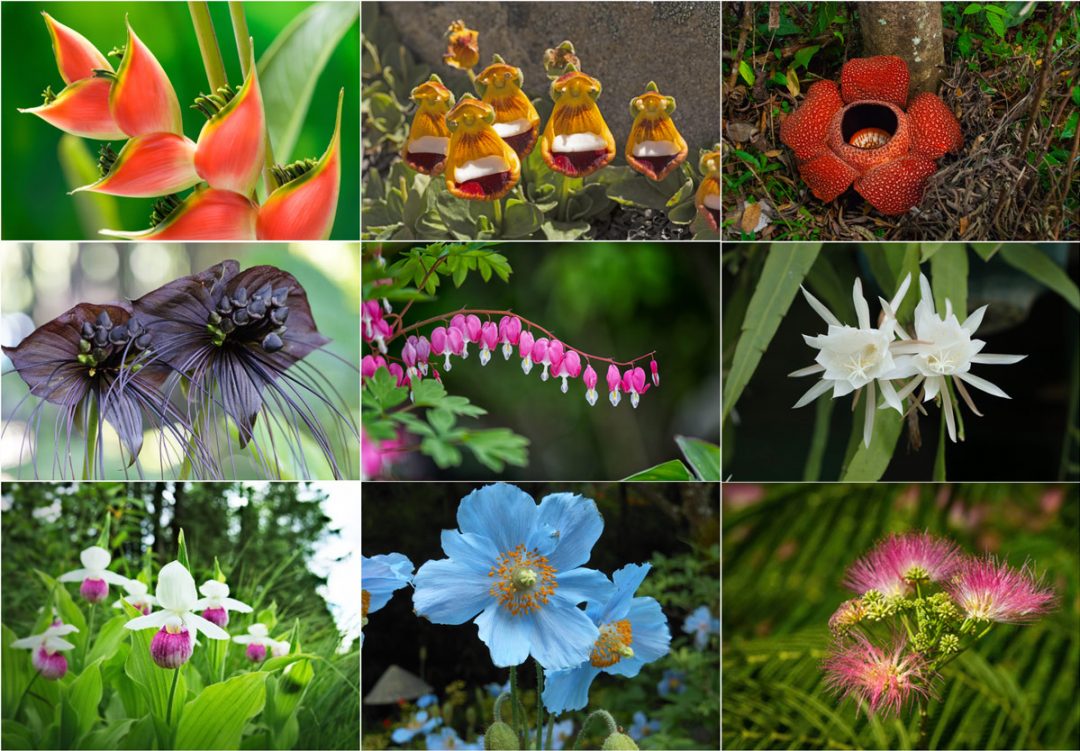If you think all flowers are beautiful, we’re not here to argue with you. However, sometimes red roses and white daisies can become a bit boring. Like most things in life, unfamiliar and rare flowers are a bit more exciting than the run-of-the-mill options. Catching a glimpse of a flower few people will ever see or decorating your home with some tropical flower bouquets can really liven up your day.
The catch is that not everyone knows about these beautiful, elusive flowers! We’re going to introduce you to some rare and exotic flowers that you can take a trip to see, as well as some that will work well in a garden or as part of a bouquet. If these flowers captivate you, consider using one as a flower background for Zoom.
Rare Flowers Around the World
Almost every corner of the world is home to rare flowers. Some of these plants have become endangered due to habitat loss or a changing climate while others were uncommon from the start. No matter the case, spotting any of these rare flowers is something to celebrate.
Youtan Poluo (Ficus racemosa)
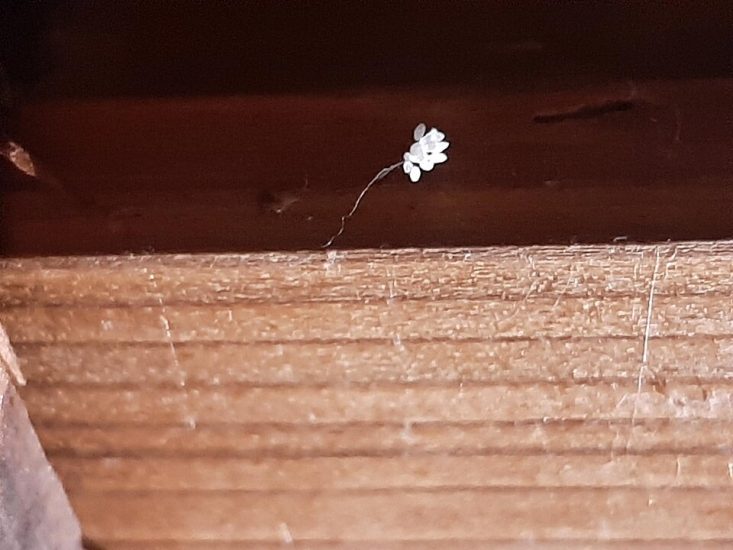
Credit Wikimedia Commons: https://commons.wikimedia.org/wiki/File:Udumbaraflowerlyonfrance2022.jpg
This mysterious flower has baffled botanists for years. Believed by some to bloom only once every 3,000 years, the Youtan Poluo is an elusive species shrouded in myth and spiritual symbolism, especially in Buddhist lore. The tiny, fragrant white flowers are smaller than a grain of rice and have been spotted in unexpected places — like on steel or wooden surfaces — adding to their enigmatic allure. Their true classification remains debated, making them as puzzling as they are rare.
Care: No confirmed cultivation method; often found on inanimate objects. Treat sightings as curiosities rather than viable plants to grow.
Batwing Coral Tree (Erythrina vespertilio)
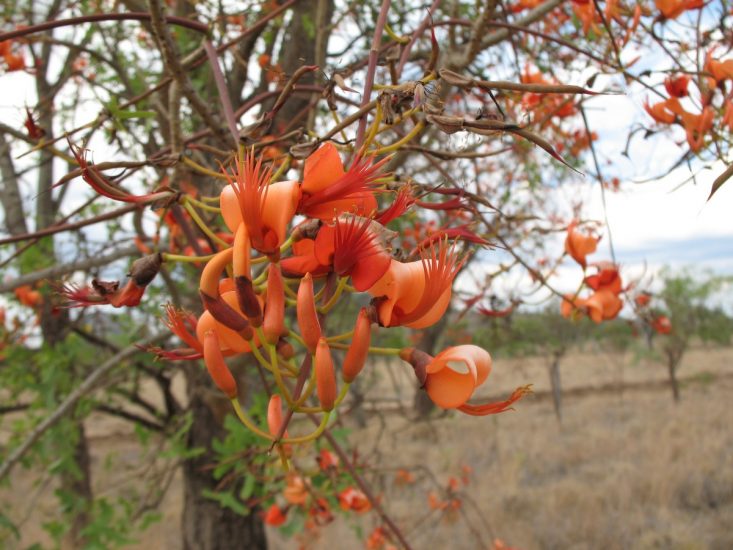
Native to Australia, the batwing coral tree earns its name from its unique, bat-shaped leaves. However, it’s the vibrant red-orange flowers that steal the show. Blooming in clusters on bare branches before the leaves return, these flowers attract native birds and pollinators. While not impossible to grow, this small deciduous tree is rarely seen outside of its native range, giving it a special place among Australia’s exotic flora.
Care: Needs full sun and well-drained soil. Drought-tolerant once established; prune in winter to shape and encourage flowering.
Torch Ginger (Etlingera elatior)
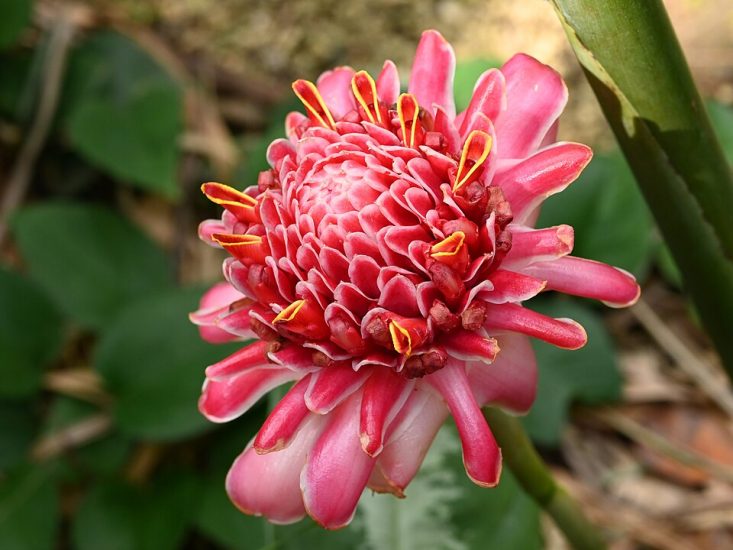
Credit Wikimedia Commons: https://commons.wikimedia.org/wiki/File:Etlingera_elatior_kz01.jpg
Also known as porcelain rose or red ginger lily, this tropical beauty is native to Southeast Asia and is often used in both ornamental landscaping and regional cuisine. The enormous, waxy blooms come in brilliant shades of pink, red, and even coral. With its towering stalks and dramatic flowers, the torch ginger makes a bold statement whether in a garden or a lush tropical bouquet.
Care: Grow in tropical or subtropical zones. Needs rich, moist soil and partial shade. Keep protected from frost.
Blue Puya (Puya berteronian)

Blue flowers are rare in their own right. Add in the blue puya flower’s large size and trumpet-like shape, and you’ve got yourself a stunning specimen. The blue puya is a type of terrestrial bromeliad that’s related to the common pineapple. However, these plants are much more rare than the common fruit. If you want to see a blue puya, your best bet is to head to their native habitat in Chile.
Care: Requires dry, rocky soil and full sun. Best suited for arid gardens or greenhouses with excellent drainage.
Parrot’s Beak (Lotus berthelotii)

Also known as the lotus vine flower or pelican beak, this uncommon flower is native to the Canary Islands off the coast of Spain. Although they can be found in cultivation, wild plants are exceedingly rare. It only takes one look at the bright blooms to see where this plant got its name.
Care: Prefers full sun and sandy, well-draining soil. Tolerates drought but not humidity. Grow as an annual or indoor plant in cooler climates.
Middlemist Red Camellia (Camellia species)

While camellias aren’t very rare, you can only see this specific type of camellia in two locations! In the early 1800s, this species likely existed throughout China. However, it became extinct in the wild by the end of the century. The only plants that were in existence were those that were cultivated indoors. Today, one plant exists in New Zealand and the other is in Great Britain.
Care: Rare in cultivation; best in cool, temperate climates. Needs acidic, well-drained soil and dappled shade. Avoid waterlogging.
Queen of the Night (Epiphyllum oxypetalum)

Catching a glimpse of this cactus’ blooms, also known as Kadupul flowers, takes a fair bit of patience. Not only do the plants rarely bloom, but the flowers emerge at night and wither by dawn. While the plants are native to Mexico and South America, you can grow them indoors. Additionally, cultivated plants have escaped and can now be found throughout countries like Sri Lanka.
Care: Grow in bright indirect light indoors or partial shade outdoors. Let soil dry between waterings; blooms at night with short-lived flowers.
Catherine-Wheel Pincushion (Leucospermum catherinae)

A type of protea, this flower is perhaps the most attractive member of the group of fireworks pincushion flowers. While you may think the elongated portions are petals, they are actually individual flowers. This protea species is considered endangered in its native South Africa.
Care: Requires sandy, acidic soil with excellent drainage. Full sun is ideal. Avoid phosphorus-rich fertilizers.
Ghost Orchid (Dendrophylax lindenii)

While the ghost orchid’s white flowers are unique, what really sets it apart is its lack of leaves. Unlike most plants, this orchid photosynthesizes via its roots rather than its leaves! Like a ghost, it can be a bit elusive to find since the species is endangered in its native habitat of Florida and Cuba.
Care: Nearly impossible for home cultivation. Grows only in high-humidity, swamp-like conditions, on specific host trees. Protected in the wild.
Darwin’s Slippers (Calceolaria uniflora)

A member of the slipperwort family, this plant is native to the southern tip of South America. While the name suggests the flowers look like a pair of slippers, some people think they resemble flocks of orange penguins or aliens with their mouths wide open. These plants are quite rare, and it’s not uncommon to find counterfeit seeds.
Care: Needs cool, alpine conditions with well-drained, gritty soil. Best grown from seeds in controlled environments with ample sunlight.
Jade Vine (Strongylodon Macrobotrys)
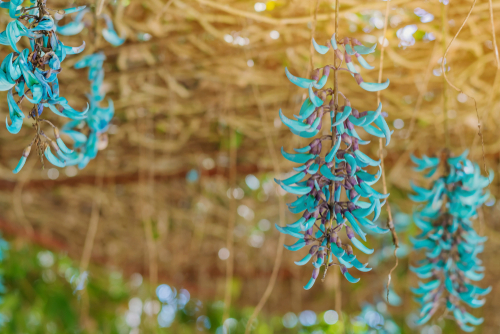
Native to the Philippines, the jade vine produces hanging clusters that can contain up to 75 of the stunning turquoise flowers. Since the flowers resemble claws, the plant also goes by the name tiger claws. The hanging flowers are pollinated by bats, but deforestation in the Philippines is threatening both the flowers and the bats.
Care: Requires tropical conditions with high humidity, filtered light, and consistently moist, rich soil. Needs support to climb and room to spread.
Lady’s Slipper Orchids (Cypripedium spp.)

Although these flowers are orchids, they look quite different from the ones you may have growing in your home. They emerge from forest floors across the United States and other temperate areas, but finding one can take some patience as well as knowledge of your local area. There are numerous species of lady’s slippers, including the showy lady’s slipper pictured above.
Care: Prefers woodland conditions that have moist, well-drained soil with partial shade. Often slow to establish and sensitive to disturbance.
Exotic Flowers for Your Garden
While you probably enjoy classic flowers like daisies and roses, sometimes you’re looking for other flowers for home gardens. Try planting a few of the following flowers to give your garden an exotic look.
Purple Passionflower (Passiflora incarnata)

While this flowering vine is native to the Southeastern United States, it certainly provides an exotic look! Since each flower blooms for only a day, it’s a treat to come across the wild blooms. If left to mature, the flowers will transform into sweet and juicy passionfruit. The purple passionflower is also the state flower of Tennessee – check this out if you’re interested in learning all 50 state flowers.
Care: Full sun to partial shade; climbs with support. Needs well-drained soil. Can spread aggressively in some areas.
Himalayan Poppy (Meconopsis betonicifolia)

While flowers come in all kinds of colors, true blue blooms can be a bit difficult to find. Himalayan poppy flowers bloom for only a few days, but they make a stunning display while they last. Like most poppies, you can grow the delicate flowers from seed. However, before you plant these flowers in your garden, you should be aware they can be a bit difficult to grow.
Care: Prefers cool, damp climates with partial shade. Needs rich, moist, well-drained soil. Difficult to establish; mulch in winter.
Chocolate Cosmos (Cosmos atrosanguineus)
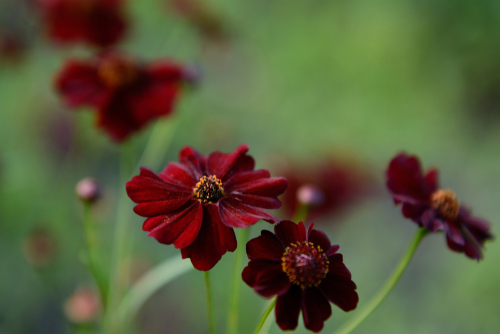
You may already have some pink or white cosmos flowers in your garden. But how about chocolate cosmos? These tuberous perennials are native to Mexico, where they thrive in sunny and dry environments. With the right care, these plants will produce handfuls of dark red blooms that smell like chocolate! While they may smell enticing, these flowers don’t taste like the candy bars we love.
Care: Full sun and well-drained soil. Mulch in colder zones or lift tubers to overwinter indoors.
Bleeding Heart (Lamprocapnos spectabilis)

Native to forests in China, the bleeding heart plant will thrive in many temperate gardens. These large, herbaceous plants produce hundreds of pink flowers that resemble the namesake bleeding hearts. Since these plants thrive in shade, they make a great addition to forest understories or shade gardens.
Care: Thrives in shade with moist, rich soil. Mulch to retain moisture; goes dormant in summer heat.
Crown Imperial (Fritillaria imperialis)

Also known as the imperial fritillary or upside-down tulip, the crown imperial looks a little like it got its directions mixed up. However, this plant is known for its gorgeous downward-facing flowers. The plant is native to regions in the Middle East and South Asia, but it can be grown elsewhere.
Care: Plant bulbs in well-drained soil in full sun. Needs cold winter to bloom well. Avoid wet conditions to prevent rot.
Pitcher Plants (Sarracenia spp.)
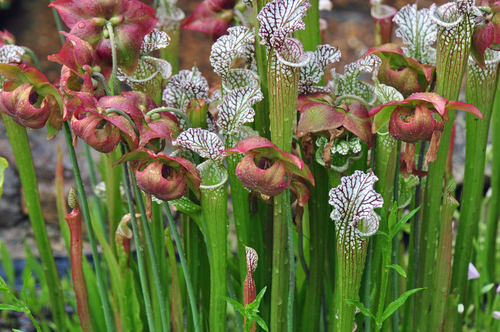
While there are a wide variety of pitcher plants, this genus of trump pitchers is native to North America. These interesting plants have a long funnel made out of modified leaves. A combination of the plant’s appearance and scent lure tiny insects which then fall inside the pitcher, where the plant digests the prey. The plants also produce flowers with interesting umbrella-shaped styles that catch falling pollen.
Care: Grows in boggy, acidic soil. Requires full sun and distilled or rainwater. Avoid fertilizing; feeds on insects naturally.
Sea Holly (Eryngium spp.)

This genus of plants has spiky blue flowers that look a bit like thistles. The spiky cones are surrounded by serrated bracts, giving the flowers a frightening yet alluring appearance. As a bonus, sea holly flowers work great in bouquets!
Care: Full sun and sandy, dry soil. Very drought-tolerant. Minimal maintenance once established.
Exotic Flowers for Bouquets
If you want to spice up your flower arrangement, turn to exotic flowers. While you may not be able to take a getaway, these colorful and interesting blooms will give you a taste of a tropical retreat.
Calla Lilies (Zantedeschia aethiopica)

The calla lilies’ cup-shaped blooms add an elegant form to bouquets. Cut flowers can last over a week in the vase – just be sure to handle the delicate stems and flowers with extra care. While lily is in the name, these plants aren’t actually true lilies.
Care: Moist, rich soil in full sun or partial shade. Mulch and keep soil consistently damp. Lift rhizomes in cold climates.
Bird of Paradise (Strelitzia spp.)

This genus of tropical plants produces unique flowers that resemble the stunning birds of paradise. While you can grow these plants as houseplants, the plants are notorious for the difficulty involved in getting them to bloom. Fortunately, you can purchase exotic bouquets that contain bird of paradise flowers.
Care: Bright light indoors or full sun outdoors. Requires well-draining soil and regular watering. Fertilize in growing season.
Ginger Flowers (Various Genera)

While you’re probably familiar with the pungent ginger root, you may not realize this group of plants also produce gorgeous flowers. While culinary ginger does send up flowers, growers often plant other types of ginger specifically for flower production. Some of these flowers resemble pink beehives while others look a bit like a spike covered with red feathers.
Care: Prefers warm, humid environments and rich, moist soil. Partial shade is best. Mulch and keep well-watered.
Anthurium (Anthurium spp.)

If you’re interested in houseplants, you’re probably already familiar with the anthurium. This plant sends up stems topped with spades and colorful “flowers.” The colorful portion is actually a modified leaf, and the spade it surrounds is made up of lots of tiny flowers! While these flowers are long-lasting on the plant (this makes them a perfect candidate for plant delivery), they can also last for weeks as part of a bouquet.
Care: Bright, indirect light; humid environment. Allow soil to dry slightly between waterings. Avoid direct sunlight.
Lobster Claws (Heliconia spp.)

The majority of the species in this group of flowering plants is native to tropical regions in South and Central America, but some species are native to Southeast Asia. Some species have an upright growth pattern, causing their cup-shaped colorful bracts to catch water. Other types of Heliconia produce hanging flowers.
Care: Moist, rich soil with full sun to partial shade. Needs tropical warmth and humidity. Protect from wind and frost.
The Most Unusual Flowers
If you think you’ve seen it all, wait just a moment. These unusual flowers will make your jaw drop and cause you to rethink everything you thought you know about flowering plants! From interesting scents, unique growth forms, and remarkable flowers, these plants are truly unusual!
Corpse Flower (Titan arum)

Although it’s native to the Indonesian island of Sumatra, you may be able to find the corpse flower in botanical gardens around the world. It takes this plant seven to ten years to obtain enough energy to bloom, and each humongous flower lasts for only one to two days. Plus, the flower smells like rotting flesh!
Care: Not for home gardens. Needs tropical greenhouse conditions, high humidity, and years to bloom. Grown mostly in botanical gardens.
Stinking Corpse Lily (Rafflesia arnoldii)

Yes, there’s more than one flower that smells like a rotting corpse! Also known as the corpse flower or giant padma. This plant puts out a strong stench in order to attract the carrion flies that act as pollinators. It parasitizes a member of the grape family and does not have leaves, roots, or stems. It’s also the largest single flower on Earth!
Care: Cannot be cultivated outside of natural habitat. Parasitic, with no leaves or roots. Endangered and protected.
Surprise Lily (Lycoris spp.)

While many plants produce leaves then flower shortly after, surprise lilies do things a bit differently. After you place bulbs in the ground, the plants will send up leaves that later die back. At this point, you may believe your plant is a dud. However, a few months later, the plants send up tall stalks topped with stunning flowers.
Care: Plant bulbs in full sun to partial shade. Let foliage die back naturally after blooming. Tolerates neglect well.
Silk Tree (Albizia julibrissin)
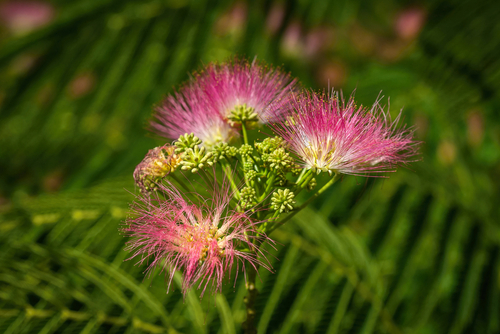
Also known as mimosa trees, these small trees produce silky flowers that resemble little pom-poms. If that’s not enough of a reason to love them, they have a uniquely sweet fragrance. Although these trees are native to much of Asia, they have become invasive in parts of the United States. So keep that in mind before you add one of these trees to your yard.
Care: Grows in full sun and well-drained soil. Can tolerate drought. Invasive in some areas—check before planting.
Black Bat Flower (Tacca chantrieri)

It’s uncommon to find a black flower. It’s extraordinarily rare to come across a dark flower as strange looking as the black bat flower. These plants are native to Southeast Asia, where they grow in the understories of forests. Bat plants also come in other colors, but there’s something magical about this one.
Care: Needs high humidity, indirect light, and consistently moist, well-draining soil. Best suited for greenhouses or terrariums.
Girlfriend Kiss (Palicourea elata)

While the small yellow flower of the girlfriend kiss plant isn’t anything special, the bright red bracts surrounding the bloom are unlike anything else you’ve ever seen…except for a pair of lips, of course. This plant is extremely sensitive to environmental conditions and is rarely found outside of its native habitat in South and Central America. And since its native rainforest environment is being threatened by deforestation, this plant has become endangered.
Care: Very difficult to grow outside tropical rainforests. Requires humid, shaded conditions and fertile, moist soil. Threatened by habitat loss.
The Rare Beauty All Around
From striking shapes and vivid colors to fascinating histories and elusive habitats, these rare and exotic flowers remind us just how extraordinary the natural world can be. Whether you’re planning a garden makeover, seeking a unique bouquet, or simply daydreaming of far-off places, these blooms offer a window into the planet’s botanical wonders. With each petal and fragrance, they inspire awe, curiosity, and a deeper appreciation for biodiversity. So the next time you spot a flower you’ve never seen before, take a closer look—it might just be one of nature’s best-kept secrets.
Check out the exotic flower delivery options we have available at Bouqs to liven up life’s vibrant occasions. Send the most fragrant flowers to add a tangible element to your gift, as it will permeate the room as they enjoy the bouquet’s vase life. For more, discover our posts about flowers with medicinal properties and the toughest to grow flowers.
Shop All
